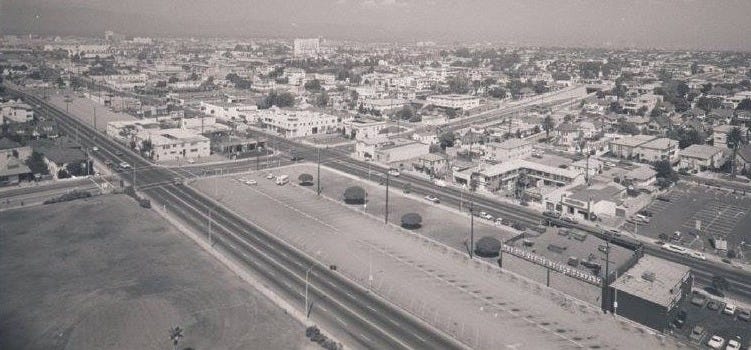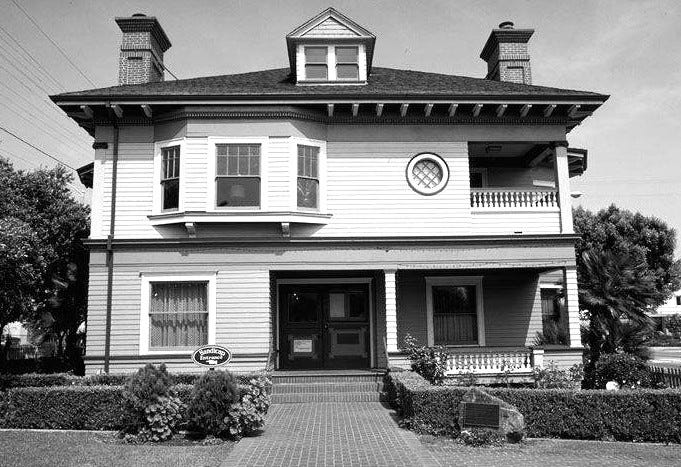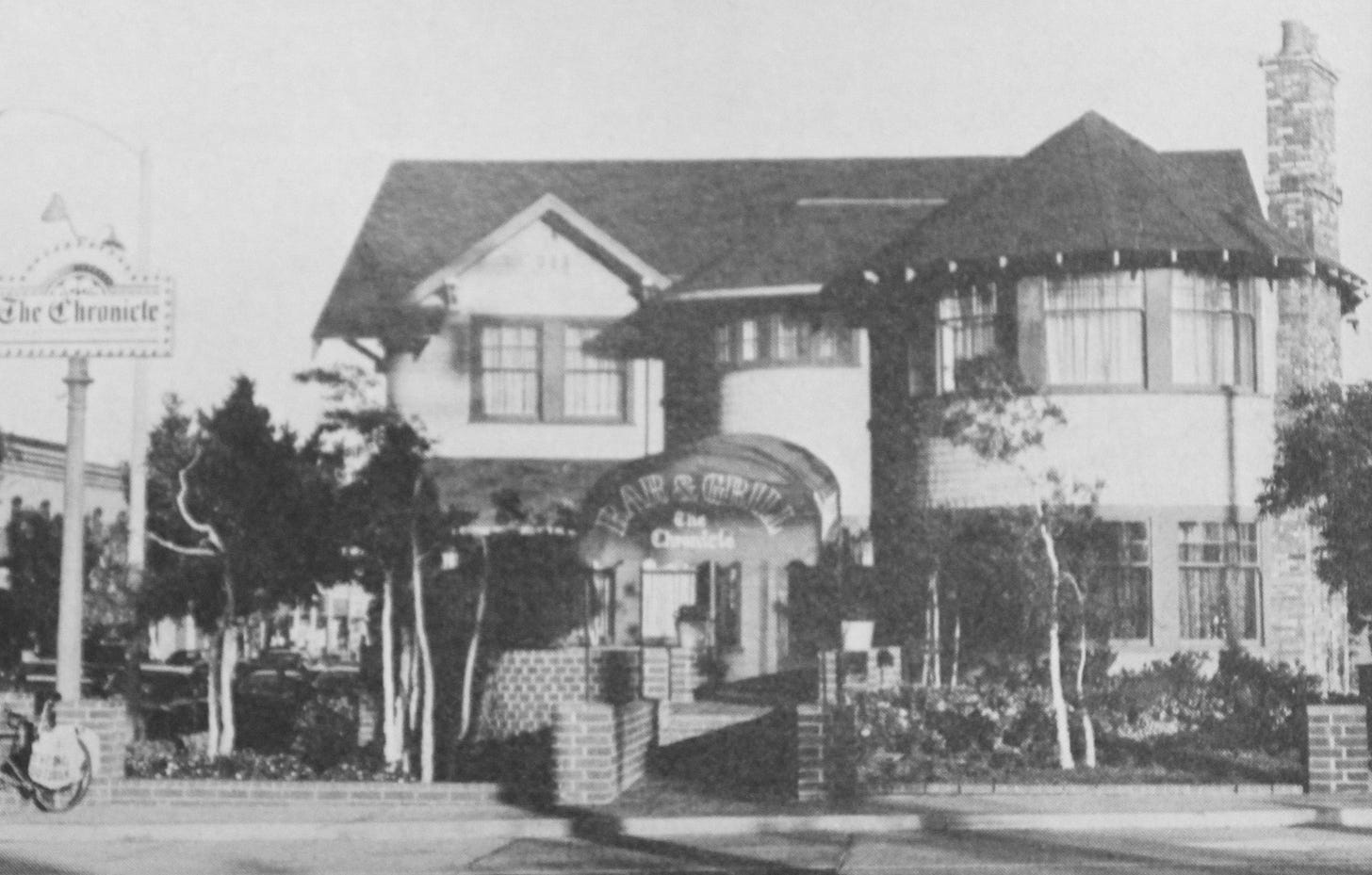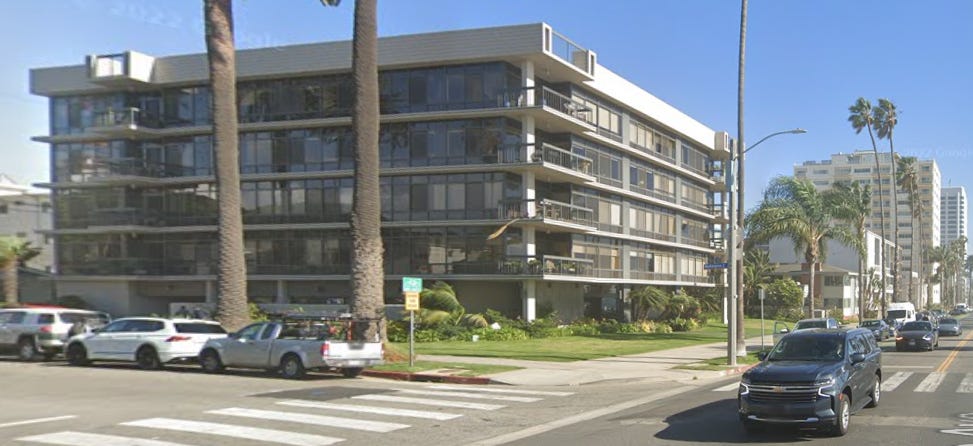Conceived at the time of the City's centennial in 1975, the Heritage Square project involves moving two historic houses from Ocean Avenue to a vacant city lot at Main St and Ocean Park Blvd. Before it opens in 1978, the project becomes entangled in local opposition and the newly formed Coastal Commission.
By the late 1960s, the southwest corner of Main St at Ocean Park is cleared of structures.1 The vacant property is owned by the Santa Monica Parking Authority.2
In 1972, the two towers of the Shores of the Ocean Park Redevelopment Project are completed. After years of demolition and construction, Ocean Park anticipates a rejuvenation. And 1975 is the City's centennial.
Meanwhile, 2 miles north on Ocean Ave at Washington Ave, Boca Monica wants to remove two historic houses (1003 Ocean and 1007 Ocean) to make way for a condominium project.3 Local activists rally to preserve the two historic buildings.4
A proposal is made to move the two historic houses - from Ocean Avenue onto the vacant Parking Authority lot at Main St and Ocean Park Blvd. The 1003 Ocean house (Trask-Kyte) would be re-adapted as a restaurant, and the adjacent 1007 Ocean house (Roy Jones) as a museum. Boca Monica agrees to donate both buildings to the City - with the condition that they be removed from the Ocean Ave site.
In November 1975, the City Council appoints a committee to flesh out the plan.5 Pat Schneider, a City Planning Commissioner, spearheads the drive. A restaurant tenant for the Trask-Kyte House is found6 - the Chronicle - a branch of the Pasadena Chronicle restaurant.7 The Roy Jones House site, slated to be a museum, struggles to obtain funding.8
The Heritage Square project9 is headed for Coastal Commission approval on the consent calendar at the March 1976 meeting. However, at the meeting, several Ocean Park residents (Galanter, Shulman, and Powell) ask for a guarantee that the project will contain a museum or, in lieu of that, some sort of public use of an equivalent portion of the property.10 The Heritage Square project is pulled from the consent calendar and the Coastal Commission schedules a public hearing for its April meeting.
At the April 1976 Coastal Commission meeting, the concerned residents insist that the Parking Authority property is a grass-covered public recreational area. Coastal Commission rules require a 2/3 commission vote to permit a use other than recreation. As only 7 of the 12 commissioners are present, action on the Heritage Square project is postponed until the May meeting.
Following the April 1976 Coastal Commission meeting, citing delays and uncertainty in obtaining a permit, the Chronicle pulls out. With the restaurant gone, the City Council abruptly informs the Coastal Commission that it is withdrawing the Heritage Square project.11
In May 1976, a revival. The Coastal Commission, the City Council , and Chronical indicate they are interested in proceeding. In July 1976, the Coastal Commission approves the Heritage Square project on an 8 to 0 vote.12
In December 1976, the City Council officially accepts possession of the two historic Ocean Ave houses to form the nucleus of the Heritage Square local history project in Ocean Park. Moving is scheduled for first week of February 1977.13
The Chronicle Bar and Grill opens January 1978.14 The Roy Jones House is designated as a City Landmark in 1979. 15 The Santa Monica Heritage Square Museum opens in 1981.16
By 1973, Saul’s service station at 2612 Main, Sam's auto service at 2616 Main, and Olivia’s Place at 2618 Main are all gone.
In 1950, the City of Santa Monica establishes the Parking Authority for the acquisition or building of parking, and the maintenance and operation of parking lots and parking structures. The City Council sits, as needed, in the Council Chambers, as the Parking Authority. The Parking Authority owns parking lots #9 & #10 & #11 behind Main St.
After Boca Monica files for their building permit, Santa Monica adopts a Landmarks ordinance, and there is a question of whether the two properties should be reviewed by the new Landmarks Commission. In a 1975 review of the two dilapidated “carpenter gothic” buildings, the Architectural Review Board (ARB) votes that there are “no redeeming architectural features to either building.”
The Santa Monica Historical Society is formed in 1975 with former mayor Clo Hoover as president.
While Heritage Square is on City owned property, there is a stipulation that no City funds be expended on the project. All of the funding must be raised from private donations.
By 1978, the museum structure remains something of an eyesore - its rehabilitation dependent on private contributions. The City Council allocates $100,000 of a federal community development grant to the Heritage Square Museum. Councilperson Perry Scott objects to using the federal funds for the project which was originally not to have cost the city anything but rather be established entirely with community contributions.
The City consulted 40 restaurateurs, but only two specific proposals were received - the Chronicle, and Grand American Fare, the operators of the Oar House and lessors of the Old Venice Noodle Company.
In December 1975, the City Council authorizes negotiations to lease the City land to the Chronicle, and in February 1976, approves the restaurant lease.
It will take $50,000 to move the Roy Jones House. To fund the rehabilitation, a plan is briefly floated to sell bricks from a to-be-demolished Rapp Saloon. By 1981, $300,000 (including the controversial $100,000 federal grant) has been spent. Another $150,000 is estimated to be needed to complete the restoration.
The Heritage Square project and the Boca Monica Condominium project, interrelated but separate projects, are both before the Coastal Commission.
While their expressed concerns are limited, the Heritage Square project is seen by some in the local community as an attempt of the reigning business establishment (6 of the 7 Council members live north of Montana) to turn Main St, at that time a grab bag of run-down businesses, into a trendy gentrified boulevard.
Councilperson Christine Reed is fuming. She predicts the open space that was to be occupied by Heritage Square will disappear anyway - "The City will need cash later and will sell that plot of land to a developer. We will lose the Victorian houses and end up with a condominium and an office building.”
In May 1976, the Coastal Commission approves the Boca Monica project (pared back to a 5-story 24-unit project) - with the condition the two historic houses are not to be demolished. Boca Monica suggests to the City that there are other parties interested in acquiring the two buildings.
The Chronicle opens in 1978 with a 30-year lease. In 1990, the Heritage replaces the Chronicle, followed by Monica’s on Main in 1992, and Grand American Fare’s Victorian in 1994.
In 1982, over a squabble about philosophy and financial management with the Santa Monica Heritage Square Museum Society, the Santa Monica Historical Society withdraws its financial and volunteer support from the museum. The two groups had worked together to found the museum in 1976. In 1983, embattled Santa Monica Heritage Square Museum executive director Lee Draper (hired in 1980) resigns.














